Facebook Ad Formats Explained
Facebook offers a variety of ad formats for advertisers to choose from when promoting content on the platform. Selecting the right ad format can help maximize engagement and conversions based on campaign goals and target audiences.
This article provides an overview of the main Facebook ad formats available to advertisers in 2024. It covers popular options like photo and video ads, carousels, collections, slideshows, stories, and more.
With Facebook’s detailed targeting capabilities and extensive user base, understanding the formats at a high level can help inform effective ad strategies.
Facebook Ads Content Policies
Facebook has strict policies that all ads must follow, regardless of format. These guidelines are key to compliant, effective Facebook ads.
The main standards aim to prevent deceptive, inappropriate, or harmful ad experiences. Key requirements include:
- Ads can’t be false, misleading, or make unsubstantiated claims.
- Ads must be suitable for the age and location of the audience.
- Proper rights are needed for images, videos, and other content used.
- Rules for certain products, political ads, and regulated industries must be followed.
Specific policies prohibit things like profanity, nudity, COVID-19 misinformation, and negative self-perception claims. Restrictions also apply to ads about cryptocurrency, dating, gambling, alcohol, and more.
Additional rules cover branded content, commerce listings, Messenger ads, Page promotions, and Instagram ads.
Now, let’s review the specific ad formats available on Facebook.
1. Photo Ads
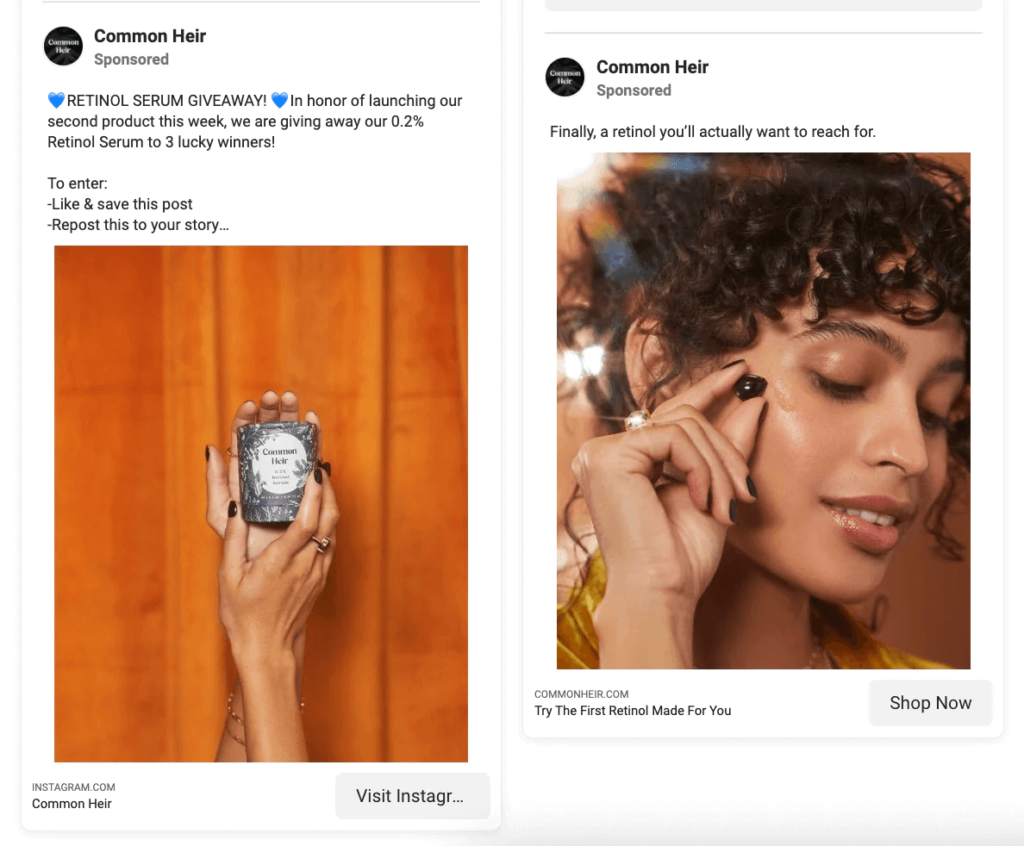
Source: Shopify
The most basic Facebook ad format is the single image ad, or photo ad. It displays a static image to capture attention and click-through to an advertiser’s landing page.
Available sizes range from 600×315 up to 1920×1080 pixels, with aspect ratios from 1.91:1 to 9:16. Square 1:1 images also work for non-feed placements. The image resolution has to meet Facebook’s requirement of at least 72 PPI (pixel per inch).
Benefits of Photo Ads
Photo ads offer a lightweight, low-cost advertising format that can effectively showcase brands. Key strengths include:
- They communicate visually through one compelling, high-impact image. This can showcase products, promotions, or brand visuals cleanly and simply.
- Photo ads work well for supplementing video, carousel, and collection ad formats. The static image brings additional visibility to amplify campaign messaging.
- Clear call-to-action buttons on image ads effectively drive traffic to advertisers’ sites or offers.
Downsides of Photo Ads
Photo ads have limited space for elaborate messaging. Without additional elements, they risk blending in with other visual News Feed content.
When to Use Photo Ads?
Photo ads work best when an advertiser has a striking visual that communicates the essence of their offer or brand. They are a simple, low-cost format to supplement video or carousel ads.
2. Carousel Ads
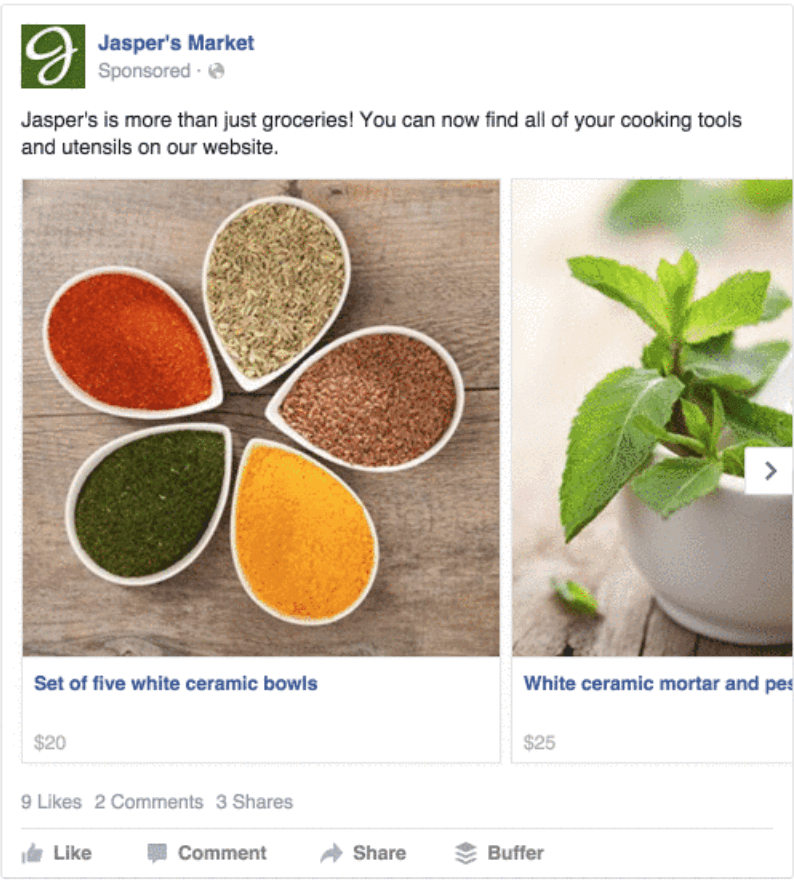
Source: Buffer
Carousel ads allow displaying a sequence of 2 to 10 images or videos that users can horizontally scroll through. They capture attention by revealing additional visuals and work well for showcasing products, services, or brand stories.
Available aspect ratios range from 1:1 to 16:9, with minimum image sizes between 600×600 and 720×720 pixels depending on placement.
Benefits of Carousel Ads
Some main advantages of multi-image Facebook carousel ads include:
- They showcase stories and messaging through a series of visuals that users scroll horizontally through. This expanded space allows advertisers to display complementary products, lifestyle imagery, or narratives.
- Carousels bring attention by revealing additional images, tapping into the compelling feeling of discovery.
- The format works well for product catalogs, tutorials, brand storytelling, and lookbooks where aligned visual flow matters.
Downsides of Carousel Ads
With multiple images, carousel ads may take longer to load or scroll through on mobile devices than single-image ads, affecting performance.
When to Use Carousel Ads?
These multi-visual ads are perfect for advertisers who have a group of complementary images or a narrative they want to guide the users through. Product catalogs, brand stories, and tutorials often work well in carousel formats.
3. Slideshow Ads
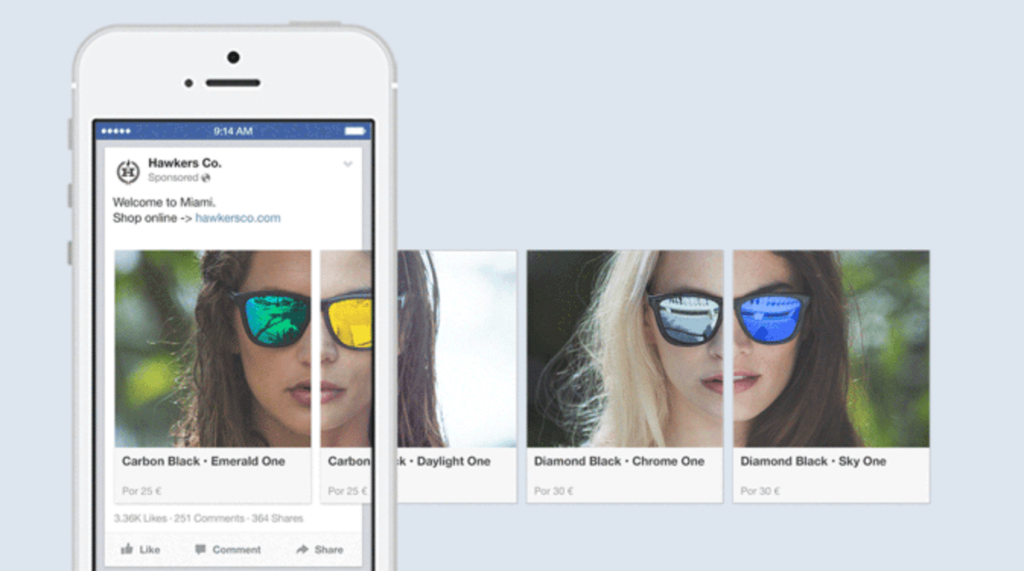
Source: Viidigital
Slideshow ads are an ad format on Facebook that plays automatically like animated GIFs. They combine the motion of videos with the silence of images for eye-catching storytelling.
Slideshows play in 20:9 widescreen format at 600×338 or 800×450 pixels. Advertisers can upload videos up to 15 seconds long, which Facebook will automatically convert into slideshow format at 12 frames per second.
Benefits of Slideshow Ads
Some main perks offered by Facebook’s slideshow ads include:
- They combine the motion of video with the condensed file sizes of silent imagery for visually striking results.
- The multi-frame animation storytelling stands out in the primarily static News Feed by catching user attention through movement.
Downsides of Slideshow Ads
Without audio narration, slideshows rely solely on visual-first messaging, so images must clearly communicate the brand’s story.
When to Use Slideshow Ads?
Creative visual narratives highlighting seasonal sales, product launches, brand stories, and events make compelling slideshow ads. The silent video format helps ads stand out from static images in the News Feed.
4. Collection Ads

Source: Shopify
Collection ads allow showcasing and promoting catalogs of products or services by pulling images directly from Facebook Business Manager catalogs.
These ads are automatically optimized to work across placements, with square 1:1 images for Feeds and horizontal images up to 1080×1920 pixels for audiences.
Benefits of Collection Ads
Some main upsides of Facebook’s automated collection ad format:
- They pull product images directly from e-commerce catalogs to instantly generate promotions showcasing inventory groups.
- They automatically adapt the image display format based on the ad placement (feed vs. standalone) and viewing device, optimizing responsiveness.
- Retailers can promote inventory groups without individually selecting images.
Downsides of Collection Ads
If the product catalog is not organized with uniform imaging, collection ads may appear haphazard rather than cohesive when automatically generated.
When to Use Collection Ads?
Collection ads work very well for stores, online retailers, or service providers needing an automated way to display inventory categories. They save effort over manually creating product carousels.
5. Video Ads
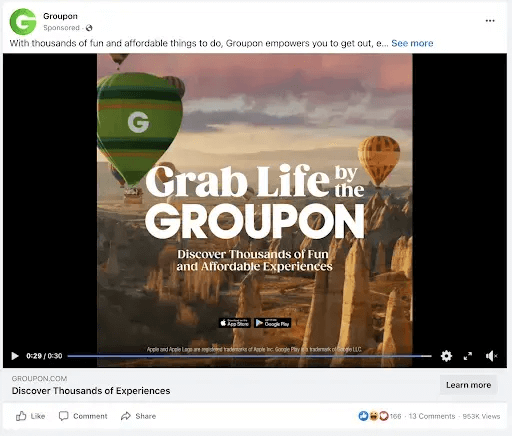
Source: UAWC Agency
Facebook video ads support several aspect ratios ranging from square to landscape to vertical video. Horizontal video ads can use 16:9 or 4:5 formats between 600×315 and 1920×1080 pixels. Vertical videos work in 9:16 or 2:3 ratios from 600×750 to 1080×1920 pixels.
Videos can run between 15 and 120 seconds. The first few seconds are critical for capturing attention, so advertisers need to use bold hooks that instantly convey their brand.
Benefits of Video Ads
- Motion and audio enable engaging storytelling that forges emotional connections at scale when crafted effectively.
- Interactive formats like demonstrations, video testimonials, and tutorials bring products, services, and brands to life.
- Bold, memorable videos excel at capturing attention and interest through visuals and sound, building brand awareness and resonance.
Downsides of Video Ads
Producing high-quality, optimized videos can be more resource-intensive for advertisers compared to basic image ads.
When to Use Video Ads?
The cinematic storytelling of videos makes them highly engaging and memorable when done right. Video ads work extremely well for demonstrations, behind-the-scenes stories, testimonials, launches, and more.
6. Stories Ads
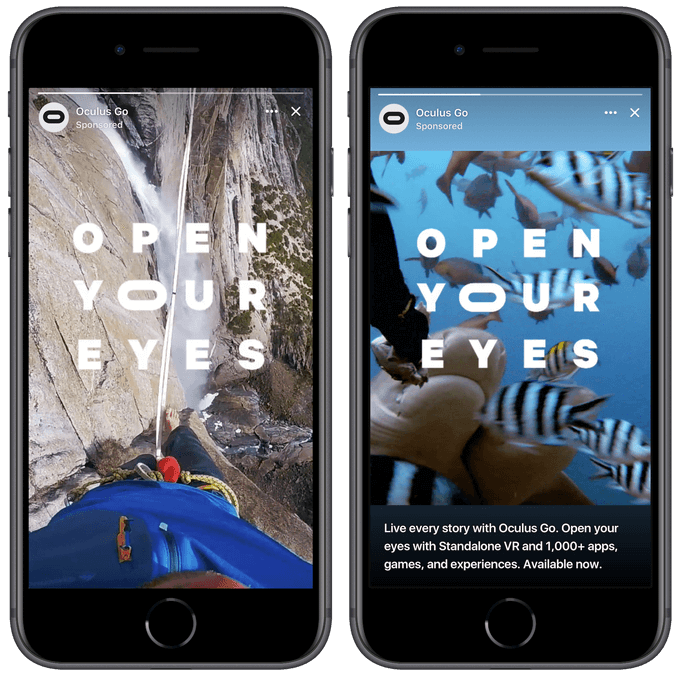
Source: Wordstream
Facebook Stories ads appear in between users’ Stories content for an immersive mobile-first experience. They are only available in a vertical 9:16 aspect ratio matching native Stories dimensions.
Advertisers can upload either images or videos to use in Stories ads. Images display for the duration chosen during creation. Videos can be up to 15 seconds long.
Benefits of Stories Ads
Some key advantages of vertical Facebook Stories ad formats include:
- They appear inline within users’ daily content streams for high visibility matched to mobile behaviors.
- Full-screen vertical placement stands out and is ideal for bold visuals around launches, promotions, and events.
- Integrating natively within frequently viewed Stories provides an immersive ad experience that drives intrigue and discovery.
Downsides of Stories Ads
Stories ads may feel intrusive when placed amidst the content from the users’ friends.
When to Use Stories Ads?
For advertisers with a relevant audience on Facebook, Stories immerse their brand amidst content people already view daily. They work for promotions, giveaways, launches, and releases that require visual presentation.
7. Messenger Ads
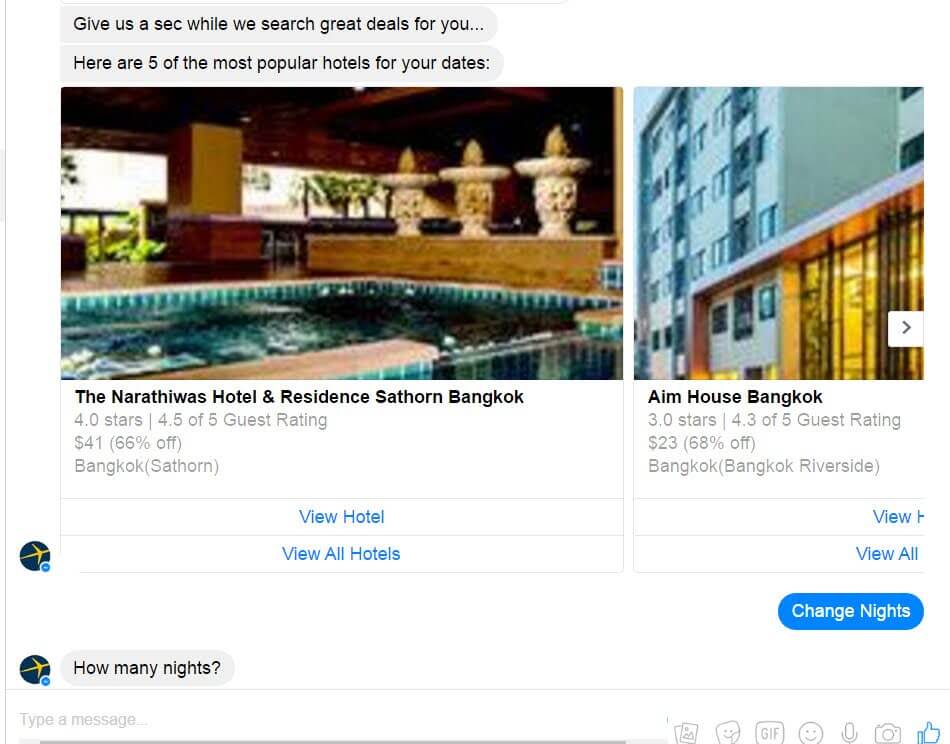
Source: Customers.ai
For businesses that can use conversational commerce well, Messenger ads can provide a direct channel for communicating their brand’s personality at scale.
These ads come in standard horizontal image and video formats following Facebook’s general size guidelines. Square or vertical formats are not currently available.
Benefits of Messenger Ads
Notable upsides of Messenger ads include:
- They enable direct conversational connections with customers at scale through automated or manned responses.
- Personable exchanges help communicate brand personality and provide customized support.
Downsides of Messenger Ads
Conversations started from ads require continued resourcing and engagement, aligning staff availability with promotion periods and the response times expected.
When to Use Messenger Ads?
For businesses that can make good use of conversational commerce, Messenger ads can provide a direct channel for communicating their brand’s personality at scale.
8. Playable Ads
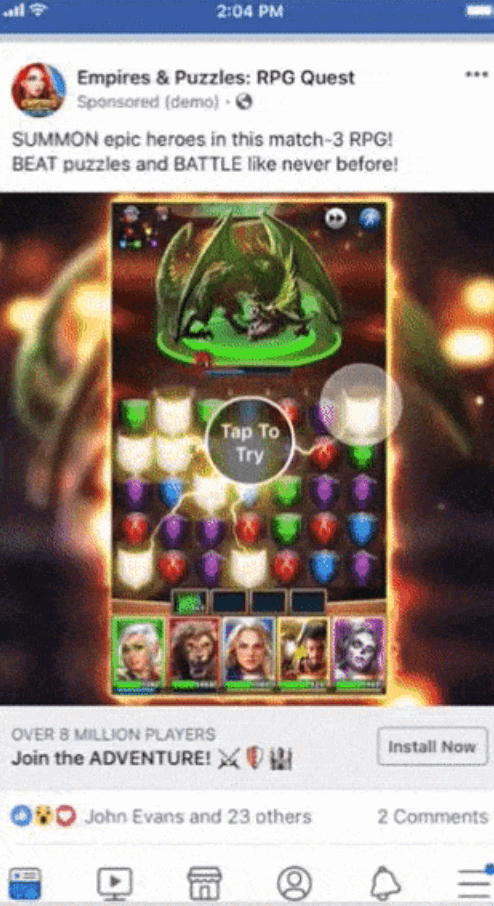
Source: WebFX
Playable ads function like interactive mini-games, allowing customers to engage directly with the ad itself before clicking through.
These ads contain components like video, audio, images, and other elements enclosed in a 300×250 or 300×50 pixel container. Users can tap or swipe to interact with the ad content.
Advertisers need to upload their assets into an interactive template using Ad Playables in Ads Manager to build a playable ad. They define how components work together, choosing from over a dozen playable formats.
Benefits of Playable Ads
Notable upsides of Playable ads include:
- Mini-game formats allow customers to directly engage with the product/service within the ad through hands-on demonstrations.
- Tactile interactions like tapping, swiping, and scrolling can effectively showcase product value.
- Playables are well-suited for categories like games, travel, and education apps, where interactivity highlights the offerings.
Downsides of Playable Ads
Playable ads require extensive upfront development efforts compared to standard static formats. Interactivity also demands more processing power, which may affect delivery on older mobile devices.
When to Use Playable Ads?
Playable ads are most effective for demonstrating products or services where user interaction highlights value. Categories that align well with this format include:
- Games – the interactive mini-game ads allow first-hand engagement.
- Educational apps – hands-on demos can showcase the value of learning.
- Travel booking – tactile interactions can mimic trip planning.
Conclusion
Facebook has many ad formats like single image ads, carousels, videos, playables, and Stories.
Each works best for specific use-cases. Photo ads showcase brands, collection ads promote product catalogs, and interactive playables demonstrate apps.
Advertisers should choose the best types of ad to achieve their goals, be it lead generation, sales, or app downloads.


